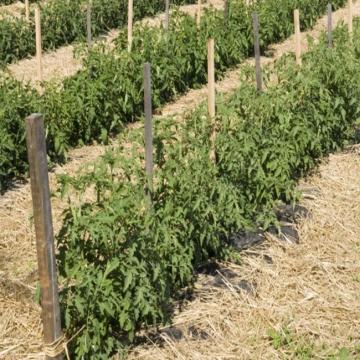Understanding Tomato Varieties: Determinate vs. Indeterminate
Before discussing support methods, it is essential to understand the difference between determinate and indeterminate tomato varieties, as each has unique growth patterns and support needs.
Determinate Tomatoes:
Determinate varieties grow to a certain height, usually 3 to 4 feet, and then stop. They produce most of their fruit at once, making them ideal for canning and preserving. Due to their compact growth, they require less intensive support but can still benefit from being kept off the ground.
Indeterminate Tomatoes:
Indeterminate tomatoes continue to grow and produce fruit throughout the growing season, often reaching heights of 6 to 10 feet or more. These "vining" tomatoes need robust support to keep them upright and prevent the vines from spreading out on the ground, which can lead to disease and reduced fruit quality.
Support Structures for Determinate Tomatoes
Determinate tomatoes are relatively easier to manage, but supporting them helps to keep the fruit clean, reduce the risk of disease, and make harvesting easier. Here are some standard support methods:
Tomato Cages
Tomato cages are cylindrical structures made of wire or metal. They provide all-around support, helping the plant to maintain its shape and keeping the branches from breaking under the weight of the fruit.
Best For: Small to medium-sized determinate varieties.
Stakes
Stakes are long, sturdy wood, bamboo, or metal poles. They provide vertical support to help keep the main stem upright. Drive the stake into the ground about 6-12 inches from the plant. Use soft ties or garden twine to loosely tie the main stem to the stake as the plant grows at intervals.
Best For: Determinate varieties that don’t grow too tall but still need support, such as ‘Roma’ tomatoes.
Tomato Ladders
Description: Tomato ladders are A-frame or ladder-like structures made from wood or metal. They provide vertical support, similar to stakes but with more stability. Place the ladder over the young plant. As it grows, guide the branches onto the ladder's rungs. This method provides excellent support and helps distribute the plant’s weight evenly.
Best For: Compact determinate varieties.
Support Structures for Indeterminate Tomatoes
Indeterminate tomatoes require more substantial support due to their continuous growth and heavy fruiting. Here are some effective support methods:
Trellises
Description: Trellises are flat, vertical structures made from wood, metal, or plastic. They provide a large surface area for indeterminate tomatoes to climb and spread. Secure the trellis in the ground behind the plants. As the tomato plants grow, gently weave the stems through the trellis or tie them loosely with garden twine. Regular maintenance is required to train the plants to the trellis.
Best For: Indeterminate varieties that grow tall and spread, such as ‘Beefsteak’ or ‘Cherokee Purple.’
Florida Weave:
The Florida Weave is a staking and weaving technique used for supporting rows of indeterminate tomatoes. It involves placing stakes at intervals along a row and weaving twine between the plants.
Place stakes every 3-4 feet along the row. As the plants grow, weave twine around the stakes, crisscrossing between each plant. This method provides excellent support and is cost-effective for larger tomato gardens.
Best For: Rows of indeterminate tomatoes, especially in larger gardens.
Stake and String Method
This method involves using a stake for each plant and running a string from the base of the plant to the top of the stake or a horizontal bar. Secure a stake in the ground and tie a string to the base of the plant. Run the string up to the top of the stake or a horizontal bar and secure it. As the plant grows, wrap the main stem around the string. This method requires regular maintenance to ensure the plant stays on the string.
Best For: Tall indeterminate varieties with strong central stems.
Arbors and Overhead Trellises:
Arbors and overhead trellises allow indeterminate tomatoes to grow vertically and then spread horizontally, creating a canopy of vines and fruit.
Construct an arbor or overhead trellis and train the tomato vines to grow up and over it. This method can create a visually appealing garden feature and make harvesting easy as the fruit hangs down.
Best For: Large, sprawling, indeterminate varieties in a spacious garden.
Here is a short video on growing tomatoes up strings for support
Supporting your tomato plants is crucial to ensuring a healthy, productive garden. Whether you’re growing determinate or indeterminate varieties, choosing the proper support structure will help you manage your plants, prevent disease, and maximize your harvest. From simple stakes and cages to elaborate trellises and arbors, there’s a support method for every type of tomato and garden space. Investing time in proper support will reward you with abundant, high-quality tomatoes throughout the growing season.

